| Yao
Yuan-Chung was born in 1931, the only sun of Yao Wen-Ing.
Yao Yuan-Chung obtained the then Predisdent Chiang Kai-shek's
favor with a series of blueprints for northern-palace style
architecture. President Chiang Kai-shek commanded Yao Yuan-Chung
to reconstruct Taiwan Huguo Jinja into a martyrs' shrine
with a northern-palace style. Yao received this honor to build
the martyrs' shrine when he was only thirty-six years old.
The only child of Yao Wen-Ing,
Proprietor of Shi-cheng Architect Firm
On the memorial stone inscribed with the chronicle of Martyrs'
Shrine, a few lines of words says, ¡§Under the orders of President
Chiang Kai-shek to reconstruct Martyrs' Shrine, on September
14th, 1967, Executive Yuan ¡K designed and overseen by Yao
Wen-Ing, architect of Shi-cheng Architect Firm ¡K¡¨ What?
Why was the architect of Martyrs' Shrine Yao Wen-Ing instead
of Yao Yuan-Chung? Actually, there were eight architects competing
for the reconstruction project at that time. The blueprint
designed by Yao Yuan-Chung was in the competition, using his
father Yao Wen-Ing's name. Later Yao won the project. Therefore,
the true architect and overseer of Martyrs' Shrine is actually
Yao Yuan-Chung, instead of his father.
Yao Yuan-Chung is seventy-six years old now. We were impressed
by his faculty of memory when he told us about his experience
of building Martyrs' Shrine.
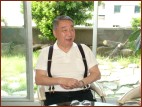 |
 |
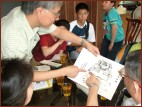 |
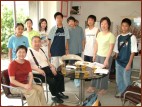 |
| Architect
of National Revolutionary Martyrs' Shrine, Yao Yuan-Chung |
Interview
with Yao |
Escorted
by Professor Tsai Jin-Tang of National Taiwan Normal University |
Photo with
Mr. Yao |
| Photos
by Li Jyun-Jhih |
Speaking
of the past
Yao told us that former Martyrs' Shrine used to be Taiwan Huguo
Jinja during Japanese Occupation, just like Yasukuni Jinja,
where national martyrs are enshrined for their patriotic deeds.
After 1945, Japanese lost the war, Jinja was on the downgrade
dramatically. However, many old jinjas were not torn, though.
They were transformed into martyrs' shrines. Because many soldiers
died in the war, generals, field grade officials, junior officers,
and privates enshrined in those martyrs' shrines. Civil officials
are enshrined in the literati martyrs' shrine, while military
officers in the military martyrs' shrine. After the war, President
Eisenhower came to Taiwan before he became the president of
the United States. He visited several martyrs' shrines and
commented, ¡§Japanese had killed so many of your countrymen,
why should your government enshrine them in an old Japanese
Jinja?¡¨ Thus, General He Ing-Chin made a suggestion to President
Chiang Kai-shek to rebuild a Martyrs' Shrine. At first, President
Chiang didn't agree due to lack of government budget. Later
in 1967, the government finally raised enough money to rebuild.
Several architects competed to this reconstruction project.
Yao Yuan-Chung's design was selected. That's how the reconstruction
plan was decided.
President Chiang demanded that the reconstruction be completed
before March 29th, 1969, he summoned Yao personally for twenty
times and personally visited the construction site twenty times.
The Yao father and son worked day and night and finally made
it on March 27th, 1969. On March 29th, 1969, President Chiang
officiated a memorial ceremony in the newly completed Martyrs'
Shrine.
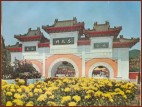 |
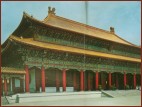 |
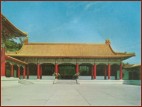 |
 |
| Archway
Entrance just finished |
Main
Hall just finished |
Martyrs'
Shrine just finished |
Main Gate
just finished |
| Image
provided by Yao Yuan-Chung, the Architect |
Yao Yuan-Chung took out a bird's
eye view of Martyrs' Shrine and explained that he applied the
northern palace style to build the shrine. Afterwards, many
martyrs' shrines in Taiwan were referred to Yao's design,
such as Martyrs' Shrine of Taichung City, Martyrs' Shrine
of Kaohsiung City. Yao Yuan-Chung founded the union of architects
in Taiwan. Besides Martyrs' Shrine, many famous buildings like
Chinatrust Hotel at Sun-Moon Lake, the Lalu¡]a five-star hotel
at Sun-Moon Lake¡^, Eight Scenes of Cheng Ching Lake, Fortuna
Hotel etc. all share the same architect, Yao Yuan-Chung.
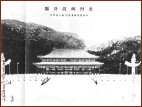 |
 |
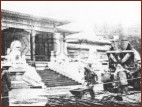 |
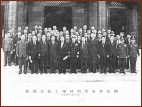 |
| Original
Design of Martyrs' Shrine |
A bird's
eye view of Martyrs' Shrine |
Martyrs'
Shrine during construction |
Completed
in March, 1969 |
| Information
provided by Professor Tsai Jin-Tan |
Representative
Totem--Plum Blossom
The totem of Martyrs' Shrine is plum blossom, instead of using
traditional patterns of fortune, longevity and prosperity, it
used our national flower¡Ðplum blossom, including potting plant,
windows, projecting tile of eaves, ancient eaves tiles etc.
You can see plum blossoms everywhere in Martyrs' Shrine, which
looks really incredible.
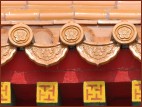 |
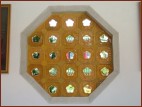 |
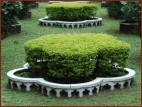 |
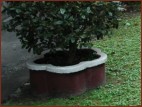 |
| Ancient
eaves tile(Wa-tang) & drip tiles |
Patterns
on a window lattice |
Plum-blossom
shape bonsai base |
Plum-blossom
shape bonsai base |
| Photos
by Li Jyun-Jhih |
(  Top )
Top )
|
|